2021人教版选修七unit1《livingwell》word教案5
人教版高二英语选修七Unit1 Living well教案设计
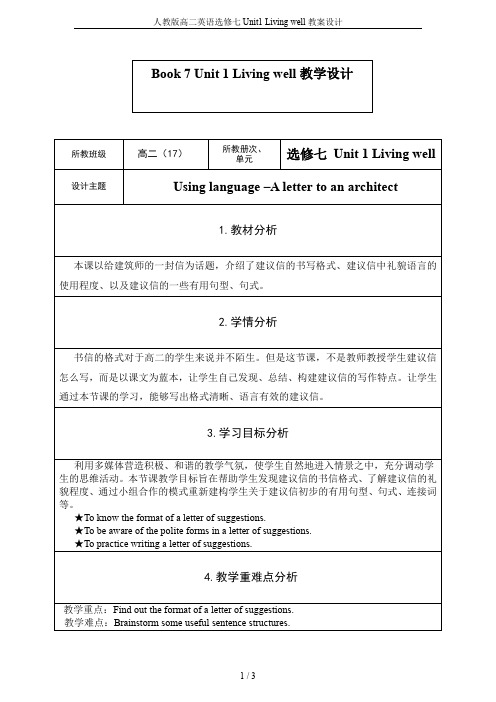
教学重点:Find out the format of a letter of suggestions.
教学难点:Brainstorm some useful sentence structures.
5.教学过程设计
教学步骤
教学活动
设计意图
时间安排
Step1
Skimming
Let students glance through the text quickly and understand three questions:
2.学情分析
书信的格式对于高二的学生来说并不陌生。但是这节课,不是教师教授学生建议信怎么写,而是以课文为蓝本,让学生自己发现、总结、构建建议信的写作特点。让学生通过本节课的学习,能够写出格式清晰、语言有效的建议信。
3.学习目标分析
利用多媒体营造积极、和谐的教学气氛,使学生自然地进入情景之中,充分调动学生的思维活动。本节课教学目标旨在帮助学生发现建议信的书信格式、了解建议信的礼貌程度、通过小组合作的模式重新建构学生关于建议信初步的有用句型、句式、连接词等。
Para1 .your writing purpose
Para2. the suggestions and measures
Para3. Your hopes and wishes
通过对文章整体格式的把握,以及每个段落细节的研讨,弄清建议信的格式,每个段落的写作内容。
10分钟
Step4
Learn and share some useful sentences structures about each paragraph.
★To know the format of a letter of suggestions.
高中英语选修七教案:unit 1 living well

一、语言要点词汇部分词语辨析1.all in all/ in all/ at all/ after all/ above all/ first of all词形变化1. disability n.无能;残疾disabled adj.伤残的able adj.能干的;能够的2. ambition n.野心,雄心ambitious adj.有雄心的,野心勃勃的3.beneficial adj.有益的benefit v.&n.受益;利益,好处4. independent adj.独立的independence n.独立depend v.依靠,依赖5.encouragement n.鼓励encourage v.鼓励courage n.勇气,精神重点单词1.ambition (n.) 雄心2.beneficial (adj.) 有益的3.adapt (v.) 使适应;改编4.conduct (n.) 行为(v.) 指挥5.resign (v.) 辞职panion (n..) 同伴7.access n. (接近的)方法;通路;可接近性8.suitable adj.适合的, 适当的;9.annoy vt. 使生气,使烦恼; 招惹; 妨碍10.adequate adj.适当的, 足够的重点词组in other words 换句话说cut out 切掉,删掉out of breath 上气不接下气sit around 闲坐着make fun of 取笑all the best一切顺利as well as 也, 又; 和……一样好重点句型1. She is proud to have taken part in competitions and to have broken a record by running two laps(800 metres) this year.2. The few who cannot see the real person inside my body do not make me annoyed, and I just ignore them.3. I have a very busy life with no time to sit around feeling sorry for myself.4. Just accept them for who they are, and give them encouragement to live as rich and full a life as you do.重点语法复习不定式(见语法专题)1). all in all/ in all/ at all/ after all/ above all/ first of all 【解释】all in all总而言之in all总共at all根本after all毕竟;别忘了(放句首时)above all最重要, 首先first of all首先IV 重点词汇(旨在提供综合运用所需材料)1. ambition (n.) 雄心ambitious adj. 志向远大的; 有雄心壮志的;有野心的be ambitious for 极欲获得be ambitious of success渴望成功be ambitious to serve the people一心想为人民服务1) Her ambition is the presidency. 她的抱负是成为一名总统2) After several hours’ work, she had no ambition to go dancing. 没有精力去跳舞了3) The prince was attracted by the girl’s beauty, and ambitious to marry her.王子为女孩的美貌打动了,渴望能娶到她。
人教版选修七Unit 1 《Living well》word教案

Unit 1 Living well Ⅰ. 单元教学目标技能目标Skill Goals▲Talk about disability and life of disabled people▲Express wishes & congratulations▲Learn expressions of formal introduction▲Revise the Infinitive▲Write a letter of suggestionⅡ. 目标语言功能句式IntroductionI’d like to introduce you to ...I’d like you to meet ...May I introduce ...?Pleased to meet you.It’s nice to meet you.Wishes & congratulationsCongratulations.All the best.I’m proud of you.I wish you success.Good luck.Well done.I’m very impressed by your performance.You have my best wishes.I’m very pleased for you.I hope it goes well for you.That’s wonderful/amazing.1.四会词汇disability, disabled, eyesight, ambition, beneficial, clumsy, adapt,词汇microscope, absence, fellow, annoy, annoyed, industry, tank, encouragement, conduct, politics, literature, resign, companion, assistance, congratulate, graduation, basement, accessible2.认读词汇syndrome, Rosalyn, Sally, Marty, fulfilling, Kilimanjaro, Qomolangma, wheelchair, Sanders, earphone, impair, community3.词组in other words, adapt to, cut out, out of breath, all in all, sit around, as well as , make fun of, never mind, all the best, meet with4.重点词汇disability, disabled, adapt, annoy, conduct, congratulate, accessible结构Revise the InfinitiveThe infinitive can be used:1. as the subject2. as the predicative3. as the object4. as the object complement5. as the adverbial6. as the attribute重点句子1. …but I am very outgoing and have learned to adapt to my disability.P22. Every time I returned after an absence, I felt stupid because I was behind the others. P23. All in all, I have a good life. P24. Just accept them for whom they are and give them encouragement to live as rich and full a life as you do. P3Ⅲ. 教材分析和教材重组1. 教材分析本单元以残疾和残疾人的生活为话题,介绍了一些残疾人凭借顽强的毅力和社会的关爱克服生活中的种种困难,以积极的态度面对人生挑战的故事。
人教版教材选修七第一单元Living Well教案
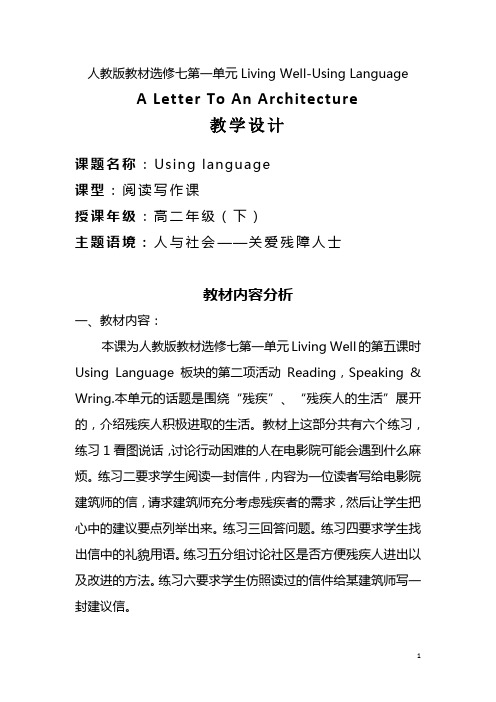
人教版教材选修七第一单元Living Well-Using LanguageA Letter To An Architecture教学设计课题名称:Using language课型:阅读写作课授课年级:高二年级(下)主题语境:人与社会——关爱残障人士教材内容分析一、教材内容:本课为人教版教材选修七第一单元Living Well的第五课时Using Language 板块的第二项活动Reading,Speaking & Wring.本单元的话题是围绕“残疾”、“残疾人的生活”展开的,介绍残疾人积极进取的生活。
教材上这部分共有六个练习,练习1看图说话,讨论行动困难的人在电影院可能会遇到什么麻烦。
练习二要求学生阅读一封信件,内容为一位读者写给电影院建筑师的信,请求建筑师充分考虑残疾者的需求,然后让学生把心中的建议要点列举出来。
练习三回答问题。
练习四要求学生找出信中的礼貌用语。
练习五分组讨论社区是否方便残疾人进出以及改进的方法。
练习六要求学生仿照读过的信件给某建筑师写一封建议信。
二、阅读文本分析:WhatReading部分呈现的是一封较为正式的写给一位电影院建筑师就新影院的设计的建议信,内容主要包括:1. 写信目的——考虑残障人士的需求;.2. 包括电梯设计(Adequate access for wheelchairs),耳机配置(Earphones for people who have trouble hearing),座位高度(Raised seating),厕所位置(Toilets)以及停车场位置(Car parking)等五个方面的建议;3. 表示感谢和期待,并表明合理设计的原因——利于残障人士也利于电影院的双赢局面。
How1. 结构上。
Reading在结构上采取了总分总的布局,先说明写信目的,随后从一些细节上体现对残障人士可能遭遇的问题的考虑而提出可行性建议,最后总结表示希望建议得到认可并进一步提出双赢的预期效益。
高中英语人教版选修7教案-Unit_1_Living_well_教学设计_教案

教学准备1. 教学目标知识目标 To master the useful expressions and sentences in the text.能力目标 To learn the text well and improve students’ reading ability.情感目标 To be positive and strong-minded when in trouble.2. 教学重点/难点重难点句型 1. Every time I returned after an absence, I felt stupid because Iwas behind the others.2. As well as going to the movies and football matches with friends, I spend a lot of time with my pets.3. I have a very busy life with no time to sit around feeling sorry for myself.4. Just accept them for who they are, and give them encouragement to liveas rich and full a life as you do.3. 教学用具4. 标签教学过程Step I: Display the preview workAsk several students to write down the preview work on the blackboard. Then check the answers together and remember them after class.Step II: Lead-inT: Well down. All of you did good jobs. I’d like you appreciate a picture. Please look at the screen. Dou you know him?S:T: His name is Nick Vujicic. From this picture, we can see he has no arms and legs, but a small foot. Would you like to know more about him? Let’s see a short video.T: Nick is positive and he tells us the disabled can live well. Inthis class, another disabled person Marty will tell us his story. Let’s come to Marty’s storyStep Ⅲ: Reading comprehensionTask1:Fast readingT: Skim the text to match the main idea of each paragraphPara.1 a) Marty met with a lot of difficulties at schoolPara.2 b) How his life has become easierPara.3 c) The advantages of his diseasePara.4 d) An introduction to Marty and his muscle diseasePara.5 e) How his disability developedTask2: Detailed readingT: Since we know the structure of the text, let’s learn some details about Marty. Read paragraph1 quickly and finish exercise2.1. When Marty says “I am one in a million”, he really means _____.A. he is uniqueB. he has a rare diseaseC. he has a muscle diseaseD. he lives a hard but happy life2. What does “live one day at a time” mean?T: Although Marty developed a rare disease, he is also optimistic. Can doctors cure him of his disease? With this question, let’s read paragraph2&3 and deal with exercise3.1. Why did the doctors cut out a piece of muscle from Marty’s leg?A. Because they could cure the disease by cutting it out.B. Because they wanted to use it as a specimen (标本).C. Because they would transplant (移植) the new muscle.D. Because they wanted to find out the cause of the disease.2. Which sentence can be replaced by the following one?After many tests in hospital, doctors still can’t find out the cause of the disease. And I don’t know what will come up in the future.T: It is a pity that doctors can’t find out the cause. If you were Marty, what would you do?S:T: What about Marty? Let’s come to paragraph4 and finish exercise4.1. What are Marty’s ambition, achievements and hobbies?T: Are you inspired by Mary’s positive attitude? If you meet a disabled person, what would you like to do? Marty not only achieved great success but also had something to tell us. Then read last paragraph and write down the answers about exercise5.2. What are Marty’s suggestions to healthy children?Task 3: Further readingT: After reading this text, what kind of person do you think Marty is?S:T: Excellent! Let’s read the text for the third time and have abetter understanding of Marty’s story.T: Work in pairs and deal with exercise 6.1. Every time I returned after an absence, I felt stupid because I was behind the others.2. As well as going to the movies and football matches with friends,I spend a lot of time with my pets.3. I have a very busy life with no time to sit around feeling sorry for myself.4. Just accept them for who they are, and give them encouragement to live as rich and full a life as you do.Step IV: SummaryT: According to Marty’s Story, fill in the blanks.Marty has a muscle disease that makes him very weak. Sometimes he is very (1) __________ and drops things or (2)________ into furniture. However he is very (3) ___________ and has learnt to(4)______________ his disability.Though (5) _________, he doesn’t look any different from others, so sometimes some children in his primary school would laugh at him. When he got (6) ______________after running a short way. His life is a lot easier at high school because his (7) _______ students have accepted him.(8)_______________, he has a good life, he is happy to have found many things he can do. His (9) __________ is to work for a firm that develops computer (10) ________ when he grows up.Step V: Free debateT: Do you know how many disabled people are there in China?S:T: Let’s look at the screen. Do you think disabled people can live a happy life like normal people now?S:T: I’d like to divide you into 2 parts. Some are for it while the others are against it. Work in group and have a debate.S:T: Different people have different opinions. They are physically disabled, but mentally strong. I firmly believe they can live well. At last, One sentence for you from Tai Lihua--Hope you can be cheerful and positive when you meet with difficulties in the future.课后习题作业1. Review what we have learnt.2. Write a short article about whether the disabled can live a happy life.。
选修7Unit1Livingwell的教学设计方案
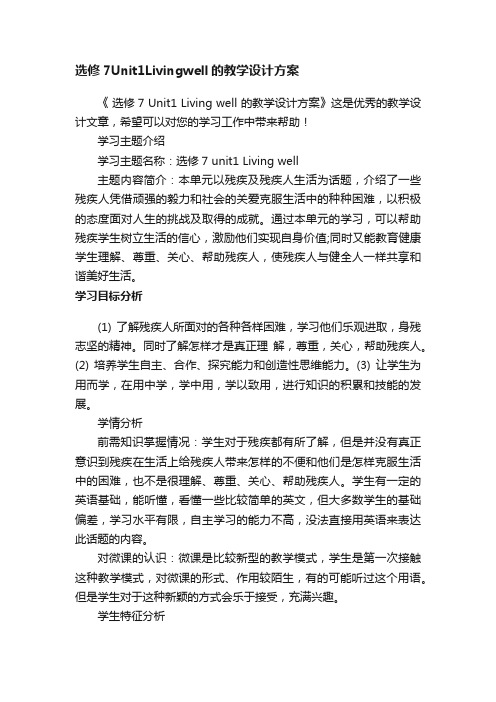
选修7Unit1Livingwell的教学设计方案《选修7 Unit1 Living well 的教学设计方案》这是优秀的教学设计文章,希望可以对您的学习工作中带来帮助!学习主题介绍学习主题名称:选修7 unit1 Living well主题内容简介:本单元以残疾及残疾人生活为话题,介绍了一些残疾人凭借顽强的毅力和社会的关爱克服生活中的种种困难,以积极的态度面对人生的挑战及取得的成就。
通过本单元的学习,可以帮助残疾学生树立生活的信心,激励他们实现自身价值;同时又能教育健康学生理解、尊重、关心、帮助残疾人,使残疾人与健全人一样共享和谐美好生活。
学习目标分析(1) 了解残疾人所面对的各种各样困难,学习他们乐观进取,身残志坚的精神。
同时了解怎样才是真正理解,尊重,关心,帮助残疾人。
(2) 培养学生自主、合作、探究能力和创造性思维能力。
(3) 让学生为用而学,在用中学,学中用,学以致用,进行知识的积累和技能的发展。
学情分析前需知识掌握情况:学生对于残疾都有所了解,但是并没有真正意识到残疾在生活上给残疾人带来怎样的不便和他们是怎样克服生活中的困难,也不是很理解、尊重、关心、帮助残疾人。
学生有一定的英语基础,能听懂,看懂一些比较简单的英文,但大多数学生的基础偏差,学习水平有限,自主学习的能力不高,没法直接用英语来表达此话题的内容。
对微课的认识:微课是比较新型的教学模式,学生是第一次接触这种教学模式,对微课的形式、作用较陌生,有的可能听过这个用语。
但是学生对于这种新颖的方式会乐于接受,充满兴趣。
学生特征分析学习态度:微课短小精悍,偏向于视觉性和动觉型,以学生喜闻乐道的方式突破教学重难点。
学生喜欢新颖的课堂模式,也愿意分组合作,积极完成任务,学生们对于这种新型的学习方式充满兴趣。
学习风格:学生学习水平有限,自主学习的能力不高,但学生喜欢新颖的课堂模式,也愿意分组合作,积极完成任务微课用于学生学习的教学策略分析微课用于学生学习的目的:通过这个微课的学习,使得学生能够在进入本单元reading前,能够掌握一些背景知识,同时通过课前热身,提高学习兴趣,为真正进入reading做好铺垫。
必修7 Unit 1 Living well 教学设计
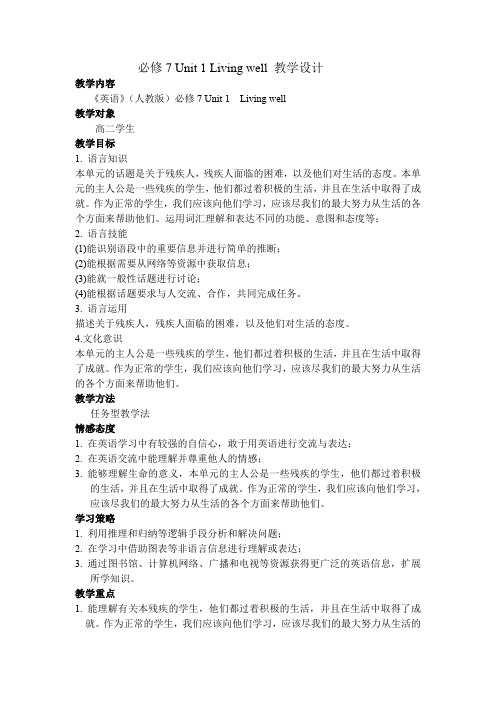
必修7 Unit 1 Living well 教学设计教学内容《英语》(人教版)必修7 Unit 1 Living well教学对象高二学生教学目标1. 语言知识本单元的话题是关于残疾人,残疾人面临的困难,以及他们对生活的态度。
本单元的主人公是一些残疾的学生,他们都过着积极的生活,并且在生活中取得了成就。
作为正常的学生,我们应该向他们学习,应该尽我们的最大努力从生活的各个方面来帮助他们。
运用词汇理解和表达不同的功能、意图和态度等;2. 语言技能(1)能识别语段中的重要信息并进行简单的推断;(2)能根据需要从网络等资源中获取信息;(3)能就一般性话题进行讨论;(4)能根据话题要求与人交流、合作,共同完成任务。
3. 语言运用描述关于残疾人,残疾人面临的困难,以及他们对生活的态度。
4.文化意识本单元的主人公是一些残疾的学生,他们都过着积极的生活,并且在生活中取得了成就。
作为正常的学生,我们应该向他们学习,应该尽我们的最大努力从生活的各个方面来帮助他们。
教学方法任务型教学法情感态度1. 在英语学习中有较强的自信心,敢于用英语进行交流与表达;2. 在英语交流中能理解并尊重他人的情感;3. 能够理解生命的意义,本单元的主人公是一些残疾的学生,他们都过着积极的生活,并且在生活中取得了成就。
作为正常的学生,我们应该向他们学习,应该尽我们的最大努力从生活的各个方面来帮助他们。
学习策略1. 利用推理和归纳等逻辑手段分析和解决问题;2. 在学习中借助图表等非语言信息进行理解或表达;3. 通过图书馆、计算机网络、广播和电视等资源获得更广泛的英语信息,扩展所学知识。
教学重点1. 能理解有关本残疾的学生,他们都过着积极的生活,并且在生活中取得了成就。
作为正常的学生,我们应该向他们学习,应该尽我们的最大努力从生活的各个方面来帮助他们。
2. 能够获取主旨大意和细节信息并利用所获取的信息解决问题教学媒体ppt, worksheet运用任务Warming Up部分通过四幅图片展示了四位残疾的学生,让同学们猜想他们都是什么样的人,是怎样生活的。
高中英语 Unit1 Living well教案5 新人教版选修7-新人教版高二选修7英语教案
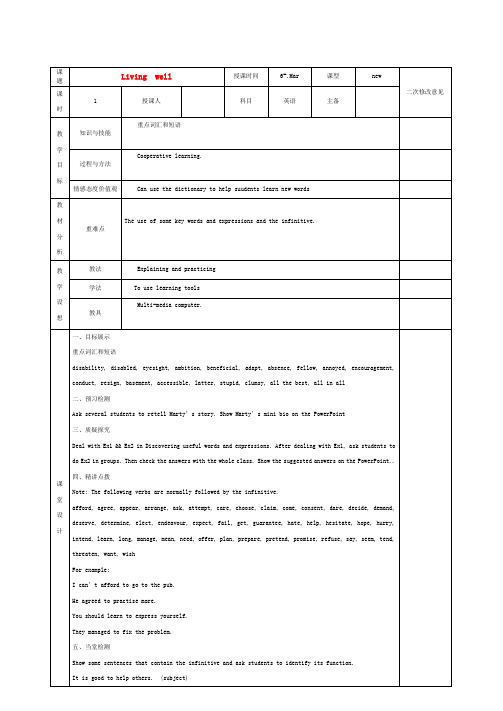
六、作业布置
Finish Ex3on Page 4.
板
书
设
计
1.Infinitive: verb + person + to-infinitive
adviseThey advise walking to town.
allowThey do not allow smoking h
2.verb+doing\to do
StopStop reading the text.Stop to read the text
forgetHe’ll never forget spending so much money on his first computer.Don’t forget to spend money on the tickets.
教材分析
重难点
The use of some key words and expressions and the infinitive.
教学设想
教法
Explaining and practicing
学法
To use learning tools
教具
Multi-media computer.
课堂设计
一、目标展示
My ambition is to work in the computer industry when I grow up. (predicative)
I don’t have time to sit around feeling sorry for myself. (attribuቤተ መጻሕፍቲ ባይዱe)
人教版高中英语选修7《Unit1Livingwell》教案
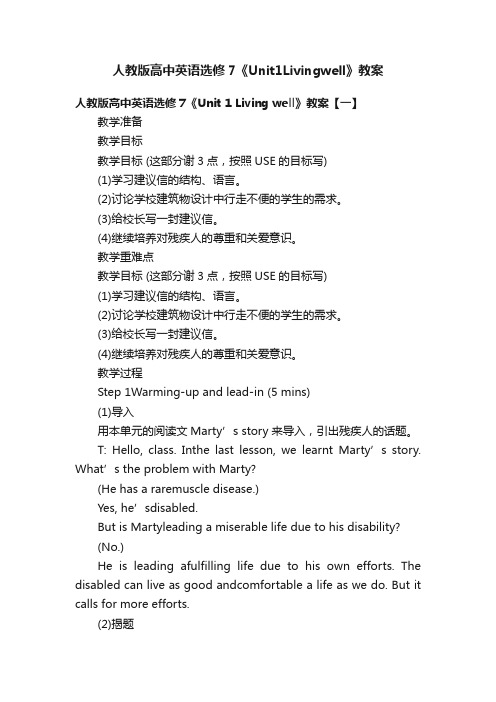
人教版高中英语选修7《Unit1Livingwell》教案人教版高中英语选修7《Unit 1 Living well》教案【一】教学准备教学目标教学目标 (这部分谢3点,按照USE的目标写)(1)学习建议信的结构、语言。
(2)讨论学校建筑物设计中行走不便的学生的需求。
(3)给校长写一封建议信。
(4)继续培养对残疾人的尊重和关爱意识。
教学重难点教学目标 (这部分谢3点,按照USE的目标写)(1)学习建议信的结构、语言。
(2)讨论学校建筑物设计中行走不便的学生的需求。
(3)给校长写一封建议信。
(4)继续培养对残疾人的尊重和关爱意识。
教学过程Step 1Warming-up and lead-in (5 mins)(1)导入用本单元的阅读文Marty’s story来导入,引出残疾人的话题。
T: Hello, class. Inthe last lesson, we learnt Marty’s story. What’s the problem with Marty?(He has a raremuscle disease.)Yes, he’sdisabled.But is Martyleading a miserable life due to his disability?(No.)He is leading afulfilling life due to his own efforts. The disabled can live as good andcomfortable a life as we do. But it calls for more efforts.(2)揭题教师通过展示我们学校的图片以及通过采访班上一位曾经有行走困难的学生,点出学校有些地方可能对行走困难学生带来不便。
然后说明教学目标:阅读一封建议信,讨论学校设施中可以改进的地方,以及写一封给校长的建议信。
T: We are lucky tobe able-bodied and study in such a beautiful school.But every now andthen, I find such students in our school. What are their problems?(They havedifficulty walking and they have to move around with walking sticks orwheelchairs.)T: This is SongYaoguang, our classmate. Yaoguang, what happened to you?Do you find itdifficult to walk around in our school with a walking stick?Do you think itnecessary to have our school reconstructed for the students with walkingdifficulty?(Yes.)T:If you have some suggestions, you can write asuggestion letter to our headmaster. Have you ever written such a letterbefore?So in today’slesson, we are going to1. read asuggestion letter2. discussproblems with the school facilities3. write a suggestionletter to the headmaster2 Reading (15 min)本课是读写结合的综合语言实践课,遵循USE的模式,即Understanding(理解)→Sharing(分享)→Expressing(表达)的模式。
高中英语选修七教案Unit-1--Living-well
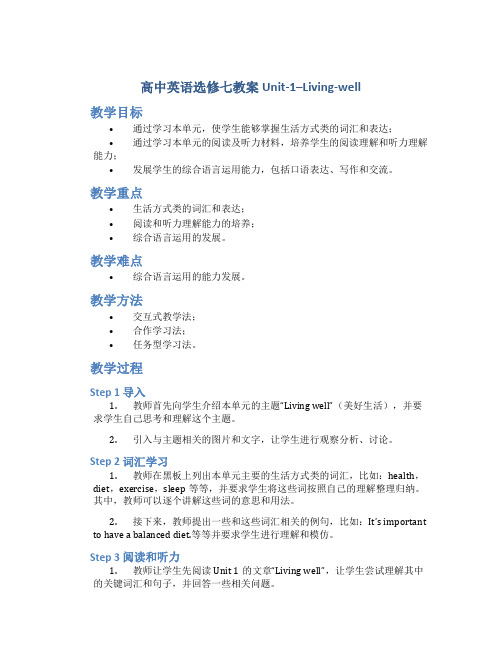
高中英语选修七教案Unit-1–Living-well教学目标•通过学习本单元,使学生能够掌握生活方式类的词汇和表达;•通过学习本单元的阅读及听力材料,培养学生的阅读理解和听力理解能力;•发展学生的综合语言运用能力,包括口语表达、写作和交流。
教学重点•生活方式类的词汇和表达;•阅读和听力理解能力的培养;•综合语言运用的发展。
教学难点•综合语言运用的能力发展。
教学方法•交互式教学法;•合作学习法;•任务型学习法。
教学过程Step 1 导入1.教师首先向学生介绍本单元的主题“Living well”(美好生活),并要求学生自己思考和理解这个主题。
2.引入与主题相关的图片和文字,让学生进行观察分析、讨论。
Step 2 词汇学习1.教师在黑板上列出本单元主要的生活方式类的词汇,比如:health,diet,exercise,sleep等等,并要求学生将这些词按照自己的理解整理归纳。
其中,教师可以逐个讲解这些词的意思和用法。
2.接下来,教师提出一些和这些词汇相关的例句,比如:It’s important to have a balanced diet.等等并要求学生进行理解和模仿。
Step 3 阅读和听力1.教师让学生先阅读Unit 1的文章“Living well”,让学生尝试理解其中的关键词汇和句子,并回答一些相关问题。
2.然后,教师在班级里播放一段与“Living well”相关的听力材料,并要求学生进行听力理解,并给出几个问题,让学生进行回答。
Step 4 综合语言运用1.教师组织学生进行小组讨论,让学生就如何“Living well”进行交流,让学生尝试用英语表达自己的想法和看法。
2.接着,教师要求学生进行写作练习,让学生就“Living well”的话题展开一段100字的写作。
Step 5 总结教师向学生概述本次课程的主要内容,并对学生的表现进行点评。
课后作业1.让学生进行生活方式类单词的记忆和复习。
人教版高中英语选修七Unit+1+Living+well说课稿.doc
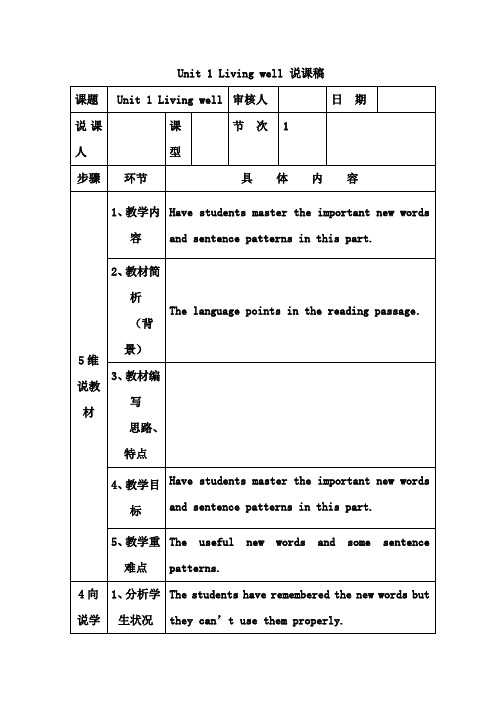
Unit 1 Living well 说课稿精美句子1、善思则能“从无字句处读书”。
读沙漠,读出了它坦荡豪放的胸怀;读太阳,读出了它普照万物的无私;读春雨,读出了它润物无声的柔情。
读大海,读出了它气势磅礴的豪情。
读石灰,读出了它粉身碎骨不变色的清白。
2、幸福幸福是“临行密密缝,意恐迟迟归”的牵挂;幸福是“春种一粒粟,秋收千颗子”的收获. 幸福是“采菊东篱下,悠然见南山”的闲适;幸福是“奇闻共欣赏,疑义相与析”的愉悦。
幸福是“随风潜入夜,润物细无声”的奉献;幸福是“夜来风雨声,花落知多少”的恬淡。
幸福是“零落成泥碾作尘,只有香如故”的圣洁。
幸福是“壮志饥餐胡虏肉,笑谈渴饮匈奴血”的豪壮。
幸福是“先天下之忧而忧,后天下之乐而乐”的胸怀。
幸福是“人生自古谁无死,留取丹心照汗青”的气节。
3、大自然的语言丰富多彩:从秋叶的飘零中,我们读出了季节的变换;从归雁的行列中,我读出了集体的力量;从冰雪的消融中,我们读出了春天的脚步;从穿石的滴水中,我们读出了坚持的可贵;从蜂蜜的浓香中,我们读出了勤劳的甜美。
4、成功与失败种子,如果害怕埋没,那它永远不能发芽。
鲜花,如果害怕凋谢,那它永远不能开放。
矿石,如果害怕焚烧(熔炉),那它永远不能成钢(炼成金子)。
蜡烛,如果害怕熄灭(燃烧),那它永远不能发光。
航船,如果害怕风浪,那它永远不能到达彼岸。
5、墙角的花,当你孤芳自赏时,天地便小了。
井底的蛙,当你自我欢唱时,视野便窄了。
笼中的鸟,当你安于供养时,自由便没了。
山中的石!当你背靠群峰时,意志就坚了。
水中的萍!当你随波逐流后,根基就没了。
空中的鸟!当你展翅蓝天中,宇宙就大了。
空中的雁!当你离开队伍时,危险就大了。
地下的煤!你燃烧自己后,贡献就大了6、朋友是什么?朋友是快乐日子里的一把吉它,尽情地为你弹奏生活的愉悦;朋友是忧伤日子里的一股春风,轻轻地为你拂去心中的愁云。
朋友是成功道路上的一位良师,热情的将你引向阳光的地带;朋友是失败苦闷中的一盏明灯,默默地为你驱赶心灵的阴霾。
人教版高二英语选修七Unit1 Living well教案设计

Unit 1 Living wellI.教材分析本单元以残疾及残疾人生活为话题,介绍了一些残疾人凭借顽强的毅力和社会的关爱克服生活中的种种困难,以积极的态度面对人生的挑战。
通过本单元的学习,可以帮助残疾学生树立生活的信心,激励残疾人实现自身价值;同时又能教育健康学生理解、尊重、关心、帮助残疾人,使残疾人与健全人一样共享美好生活。
通过本单元的言语技能训练,要求学生学会使用正确得体的英语介绍他人和向他人表示祝贺。
其中,USING LANGUAGE分为两部分,Listening and speaking是关于对残疾人Barry Minto的采访录音,要求学生能够通过录音了解Barry Minto的身体残疾和他取得的成就。
同时通过听这个采访,要求学生掌握表示祝贺的常用句型。
Reading, speaking and writing 部分要求学生先讨论腿脚残疾的人在电影院有可能遇到的困难,然后引出残疾Alice Major写给the newBankstown电影院的建筑设计师的一封信,在信中她给建筑设计师提出一些建议,要充分考虑残疾人的特殊需要。
这封信后有说和写的练习题,通过不同的言语技能训练,完成本单元教学目标。
通过读这份建议信,要求学生学会写建议信。
II.Teaching goals 教学目标1. Target language目标语言:重点词汇和短语access, company, in comfort, meet with, dignity, profit2. Ability goals能力目标Help students to learn about disabilities and life of the disabled. Enable students to do something for the disabilities.3. Learning ability goals学能目标By making designs for the convenience of the disabled, students will learn how to think for others and help others.Teaching important points教学重难点Enable students to design a building or equipments for the disabled.Teaching methods教学方法Discussing, explaining, reading and practicingTeaching aids教具准备Multimedia computerTeaching procedures & ways教学过程与方式Step I Leading inShow students a few pictures of different places of our school. Then ask students the following question:How can we adapt the buildings or the equipment or some means of transport to make them more accessible to people in wheelchairs?Discuss with the class , and then show students the pictures of some equipments which are designed for the disabled.Step II Reading 2 A letter to an architect1.Read the letter and list the suggestions the writer put forward.Suggestions1——→ Adequate access for wheelchairs.2——→Earphones for people who have trouble hearing.3——→Raised seating.4——→Toilets.5——→Car parking.2.ScanningAsk students to read the letter again and in pairs discuss the questions before writing the answers.1) What is the purpose of the first paragraph of the letter?(To tell the readers the purpose of the letter.)2) What is the purpose of the last paragraph of the letter?(To finish the letter in a polite way and to put forward some reasons why the architect should consider the writer’s suggestions.)3.Suggestions to the architectLiftsEarphonesSeatsToiletsCar parking1)Make the buttons easy to reach and the doors wide enough to enter . Make thecinema accessible to people in wheelchairs.2)Adequate access for wheelchairs. (Para2)A. means of entering/ way inB. opportunity or right to use sth. (A)3) Fit (安装/ Fix(使固定)sets of earphones to all seats to allow hearing-impaired customers to enjoy the company of their friends.4)This would allow hearing-impaired customers to enjoy the company of their hearing friends.A. firmB. companionC. fellowD. being together with sb5)The seats at the back should be placed higher than those at the front, and there could be a space at the end of each row for people in wheelchairs to sit next to their friends.Step III Language Points&Practice1. access n. [U] ~ to sth./ sp.①(接近/进入某地的)通路/途径进入农场的唯一途径是穿过田野。
高中英语 Unit 1《Living well》教案5 新人教版选修7
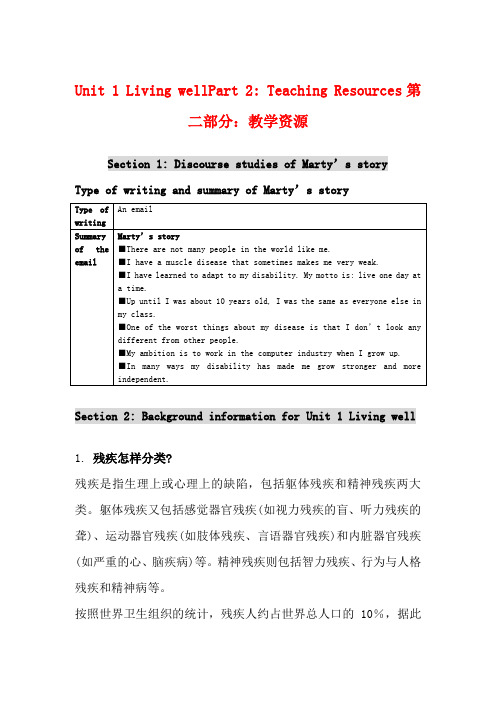
Unit 1 Living wellPart 2: Teaching Resources第二部分:教学资源Section 1: Discourse studies of Marty’s storyType of writing and summary of Marty’s storySection 2: Background information for Unit 1 Living well1. 残疾怎样分类?残疾是指生理上或心理上的缺陷,包括躯体残疾和精神残疾两大类。
躯体残疾又包括感觉器官残疾(如视力残疾的盲、听力残疾的聋)、运动器官残疾(如肢体残疾、言语器官残疾)和内脏器官残疾(如严重的心、脑疾病)等。
精神残疾则包括智力残疾、行为与人格残疾和精神病等。
按照世界卫生组织的统计,残疾人约占世界总人口的10%,据此推算,全世界残疾人约5亿。
我国于1987年4月进行的全国29个省、直辖市、自治区的残疾人抽样调查结果表明,我国残疾人占总人口的4.90%,据此推算,全国五类残疾人总数约为5164万人,其中约有听力言语残疾者1770万人,智力残疾者1017万人,肢体残疾者755万人,视力残疾者755万人,精神残疾者194万人,综合残疾者673万人。
现在全国人口已达12亿多人,按4.90%推算,残疾人也达到了6000多万人,而且由于自然环境和社会环境的变化,每天都会增加新的残疾人,这些人的心理康复问题也就关系着全社会的文明与进步。
2. Infinitive (动词不定式) 小结As Subject and Predictive (用作主语和表语)做主语,如:To master a foreign language is no easy job.但在当代英语中,不定式做主语置于句首的不多,常用先行词it 作形式主语,而将真实主语不定式移置谓语之后,即用句型"It +(be)+ adj./n.+ to v",如:It is foolish to make a decision without knowing all the facts.It's a pleasure to talk with you.如果是疑问句或感叹句,则只能用上述句型,如:How much did it cost you to repair the car?What a magnificent view it was to overlook the valley at the top of the mountain!作表语,如:The most important thing is to put theory into practice.不定式作表语通常要带to,但当主语部分含有do的某种形式时,to可省略,如:All we have to do is push the button.As Object (用作宾语)动词的宾语:能以不定式作宾语的动词很多,常用的有afford, agree, ask, attempt, beg, begin, bother, care, choose, decide, demand, desire, dislike, like, expect, fail, fear, forget, hate, help, intend, learn, love, manage, mean, offer, plan, prefer, prepare, pretend, refuse, remember, start, threaten, want, wish等,如:Laser science began to develop in 1958.如作宾语的不定式后有补足语时,用先行词it作形式宾语,而将真实宾语不定式移置补足语之后,即用"V + it + Co + to V"句型,如:I find it a pleasure to talk with you.Do you think it possible to finish the work today?介词的宾语:介词but, except, besides (= except)和than可用不定式作宾语,如:The enemy had no choice but to surrender.在谓语动词中含有do的一定形式时,或can't but和can't help but后接不定式时,不定式符号to省略,如:She did nothing but (except) weep.Whenever he asks me for help, I can't (help) but go.As Complement (用作补足语)动词宾语的补足语,如:The doctor warned me not to smoke and drink.在表示感觉的动词如see, look at, watch, hear, listen to, feel, notice等,以及在使役动词如make, have, let后的宾语补足语要省略to; help和find后的可省也可不省to,如:I saw him enter the store.He helped me (to) move the chairs.介词宾语的补足语,如:It is right for them to leave now.It was kind of you to help us.He shouted to them to stop arguing.主语的补足语,如:Everybody is expected to do his duty.John was appointed to be in charge of the sales department.主语补足语的to不省略,如:Mary's father was seen to return after dark.I was made to feel at easeIndicating Purpose/Result (表示目的和结果)不定式修饰动词表示目的,如:One should eat to live, not live to eat.为了更加突出或明确表示目的,不定式还可放在句首或用in order to, so as to的结构,如:To catch up with the advanced nations, we must make still greater efforts.We started early in order to catch the first train.We should do physical and chemical experiments so as to know the properties of molecules and atoms.不定式修饰动词、形容词和副词表示结果: 修饰形容词和副词时常用too … to, (not)enough to, so … as to, such … as to结构,如:What have you done to hurt her so much?He knows too little to speak on the subject.I'm not familiar enough with him to ask him for help.The temperature is so high as to change water into steam. The solution has reached such a temperature as not to need to be heated any more.不定式前面和only连用表示没有意想到的结果,如:They lifted a rock only to drop it on their own feet. Modifying Adjective (修饰形容词)不定式修饰表示心情状态的形容词表示原因,如:[He was grieved to hear that his old friend was seriously ill.不定式修饰一些形容词表示范围、情况,这类形容词主要有clever, comfortable, considerate, cruel, difficult, easy, foolish, (un)fortunate, free, good, hard, interesting, lucky, pleasant, proud, quick, right, rude, slow, (un)wise, wrong 等,如:You were foolish not to follow her advice.上述的某些形容词(如easy, difficult, good, hard, interesting)作表语,其后的不定式被视为省略了逻辑主语,因此不定式用主动形式表被动意思,如:English is hard (for me) to learn. (不用to be learnt) Mary is easy (by someone else) to deceive. (不用to be deceived)修饰上述形容词的不定式如与句子主语呈动宾关系,不定式是不及物动词时要带介词,但介词后不能再带宾语,如:Alice is easy to get along with. (不能去掉with,也不能在with 后加her)不定式修饰形容词作宾语,这类形容词常见的有:(un)able, afraid, anxious, content, determined, eager, (un)fit, impatient, ready, (un)willing, worthy等,如:He is eager to become a policemanAs Postmodifier in a Noun Phrase (后位修饰名词)不定式作定语都应放在它所修饰的名词或代词后面。
人教版高中英语选修七Unit+1+Living+well+(5)教案.doc
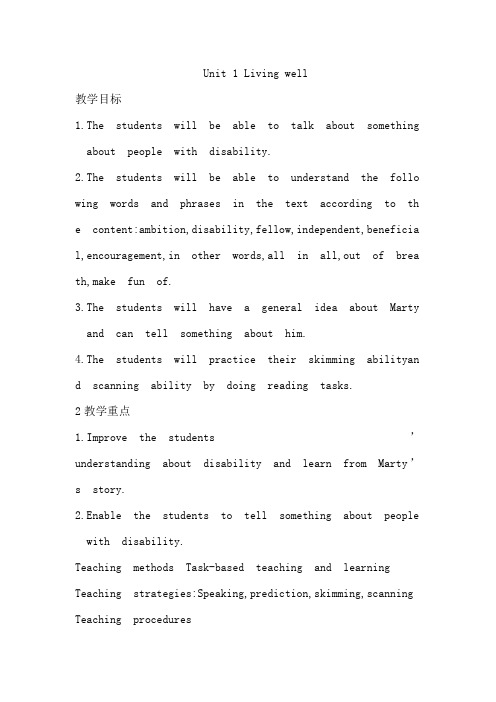
Unit 1 Living well教学目标1.The students will be able to talk about something about people with disability.2.The students will be able to understand the follo wing words and phrases in the text according to th e content:ambition,disability,fellow,independent,beneficia l,encouragement,in other words,all in all,out of brea th,make fun of.3.The students will have a general idea about Marty and can tell something about him.4.The students will practice their skimming abilityand scanning ability by doing reading tasks.2教学重点1.Improve the students’understanding about disability and learn from Marty’s story.2.Enable the students to tell something about people with disability.Teaching methods Task-based teaching and learning Teaching strategies:Speaking,prediction,skimming,scanning Teaching procedures学时难点1.Improve the students’understanding about disability and learn from Marty’s story.2.Enable the students to tell something about people with disability.Teaching methods Task-based teaching and learning Teaching strategies:Speaking,prediction,skimming,scanning Teaching procedures教学活动【讲授】living wellStep1 Lead-inPlay the music of Zheng Zhihua,and ask the followin g questions to talk about people with disability.Do you know the singer?Do you love his song?What can you get from his song?What’s his disability?Can he live well?Step2 Speaking1 Ask students the following questions.Do you know any famous disabled people?Who are they ?What do they do?2 Show some pictures of disabled people and get st udents to talk about them with the given key words .3 Get students to be familiar with other types of disability.4 thinkingWhat do you learn from these disabled?Can they live well despite of their disability? Step3 pre-readingGet students to know the website-Family Village! Read the pre-reading carefully and find out three p urposes of the website.1.To give disabled people the chance to share their stories with others2.To inspire other disabled people.3.To get non-disabled people to understand more abou t how challenging life can be for people with disa bilities.Step4 PredictionLet’s read the title and look at the picture to guess the topic.Title:Marty’s storyIt is a narrative article about Marty and probably was written in timeorder.Picture:Marty’s Hobby---------Keep fish2 Read the first sentence in each paragraph to gue ss what Marty will tellus.Para1 Name--Introduction of MartyPara2 Something bad happened when Marty was ten.Para 3 Marty‘sproblem.Para4 Marty‘s easier life.Para5 Help--good things Marty got from disability. Step5 ReadingA.Skimming(6 min.)Read the story within 6minutes to get the main ide a of each paragraph.Put the following main idea of each paragraph into order.A How his life has become easier.B An introduction to Marty and his muscle disease.C The advantages of his disease.D Marty met a lot of difficulties at school.E How the disease developed.B.Scanning:Let’s read Marty’s story step by step and get certain information. Para1:(1.5min.)You are given 1.5minutes to finish reading paragraph 1 to get thefollowing information.Disease: _________________that makes him very weak. Difficulties:_________and can’t____or______stairs as quickly asother people.Motto:To live one day______________.What does his motto mean?Live a rich and full life ever y day.Para2:(2min.)You are given 2min.to finish reading paragraph2 and try to answer thefollowing questions.1 What was Marty’s dream before he was ten?__He dreamed about playing professional football and possiblyrepresenting his country in the world cup.2 What happened to him when he was ten?__He became weaker and weaker and had a lot of te sts,but no one cangive his disease a name.3 How did Marty feel at that time?___He was hopeless.Para3:(1.5min.)You are given 1.5min.to finish reading paragraph3 an d try to answer thefollowing questions.1 why did some children laugh at Marty?Marty got out of breath after running a short way or had to stop and rest halfway up the stairs.2 Why did he feel stupid?He was too weak to go to school so his education suffered and he was behind the others.Para4:(3min.) You are given 3min.to finish reading paragraph4 and try to answer the following questions.1.How does Marty lead a happy and busy life?Marty finds many things he can do,like writing and computerprogramming.2.What are Marty’s ambition, achievements and hobby? Marty’s ambition:Work for a firm that develops computer software.Marty’s achievements:He invented a computer football game. Marty’s hobby:Going to the movies and football matches,spe nding a lot of time with his pet.Para 5(2min.)You are given 2min.to find Marty’s advice.Marty’s advice1.Don’t feel sorry for them2.2.Don’t make fun of them.3.3.Don’t ignore them4.Accept them for who they are.5.Encourage them to live as rich and full a life as you do.Step6 Further understandingLet’s find the changes of Marty’s feelings: hopeful→hopeless→stupid→not get annoyed→happyStep7 DiscussionWhat should be our attitudes to the disabled people ? What have youlearned from Marty’s inspiring story ?1. We should be patient with people with disabiliti es. We shouldn’t getannoyed just because they are slow.2. We shouldn’t feel sorry for them. That might hurt them.Step 8 Homework1. Read the text at least three times.2. Underline the language points.3. Retell the story in the third person.4. Read Zhang Yuncheng’s story on page 51 and find his problems and achievements.品味人生1、不管鸟的翅膀多么完美,如果不凭借空气,鸟就永远飞不到高空。
人教版英语选修七 Unit 1 Living well 教案

Unit 1 Living well一、学生情况分析本单元的设计与实施是建立在学生经过高一新教材学习基础之上。
学生已经逐步适应了在活动与任务中学习英语以及如何处理语言知识与活动开展的关系。
并且,他们也已经形成并培养了一定的小组合作学习及自主学习的能力。
对于残疾人的生活和学习这一话题,同学们并不感到陌生,相信这能引起学生的兴趣,并激发学生的探究心理。
二、教材分析(一)教材地位与作用Living well高中英语选修7 第一单元的内容。
本单元以残疾及残疾人生活为中心,介绍了一些残疾人凭借顽强的毅力和社会的关爱克服生活中的种种困难,以积极的态度面对人生的挑战。
本课时是第一课时,包括Warming Up,Pre-reading,Reading和Comprehending四部分。
通过本节课的学习,提高学生理解、尊重、关心、帮助残疾人意识,使残疾人与健全人一样共享美好生活。
它在整个单元教学中占有十分重要的地位。
这是对新课程目标中情感态度与价值观培养目标的全方位体现。
基于以上教材的分析,根据新课程标准要求,我确立如下教学目标:(二)教学目标1. 知识目标a. 掌握以下重点词汇和短语ambition, disability, fellow, independent, beneficial, encouragement, in other words, all in all, out of breath, make fun of.b. 理解和运用以下重点句型1. I have to adapt to my disability.2. Just accept them for whom they are and give them encouragement to live as rich and full a life as you do.2. 能力目标a. 通过对段落结构的分析,使学生掌握scanning的阅读技巧。
人教选修七 Unit1 Living well 教案-word

BOOK 7 Unit1 Living well目标认知重点词汇与短语:ambition, disability, suitable,beneficial,adapt, absence, annoy, access, assistance, congratulatein particular, in other words, adapt to, cut out, out of breath, all in allas well as, make fun of, meet with重点句型:1.疑问词+不定式2.so that3.be + adj. +to do4.used to单元重点语法:动词不定式重点词汇ambition【原句回放】Her ambition is to become part of the national team for the next Paralympic Games.(Page 1)【点拨】ambition: determination to be successful, rich, powerful etc. 用作不可数名词表“雄心,抱负”;用作可数名词表“渴望得到或追求的东西”。
【拓展】ambitious (a.有雄心的)常用短语:be ambitious for sth/to do sth 对(做)某事怀有雄心/热切的希望suitable【原句回放】Although some may think the cinema is noisy, it is suitable for Sally's condition.(Page 1)【点拨】suitable:adj.合适的,适宜的。
常用短语:be suitable for sb./sth. be suitable to do sth.【拓展】suit (v.)适合,相称;(n.)一套(衣服),套装disability【原句回放】Do you know anyone with a mental or physical disability? (Page 1)【点拨】disability:being unable to do sth., esp. taking away the power of using the leg or arm. 用作可数名词表“残疾”;用作不可数名词表“无能、劳动能力丧失”。
2021人教版选修七unit1《livingwell》word教案
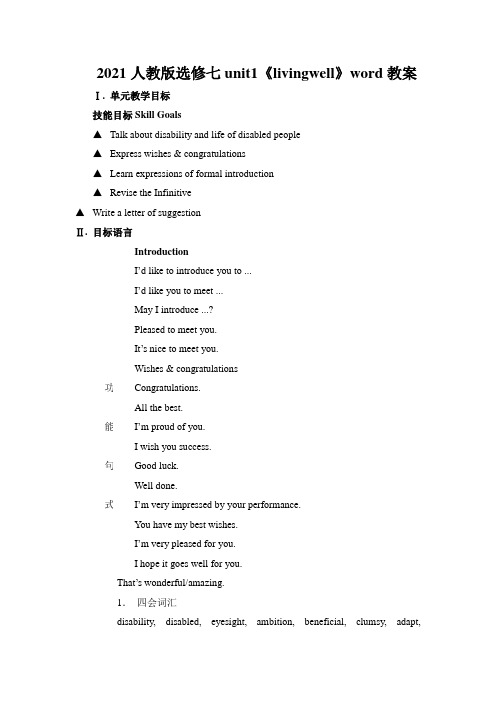
2021人教版选修七unit1《livingwell》word教案Ⅰ. 单元教学目标技能目标Skill Goals▲Talk about disability and life of disabled people▲Express wishes & congratulations▲Learn expressions of formal introduction▲Revise the Infinitive▲Write a letter of suggestionⅡ. 目标语言功能句式IntroductionI’d like to introduce you to ...I’d like you to meet ...May I introduce ...?Pleased to meet you.It’s nice to meet you.Wishes & congratulationsCongratulations.All the best.I’m proud of you.I wish you success.Good luck.Well done.I’m very impressed by your performance.You have my best wishes.I’m very pleased for you.I hope it goes well for you.That’s wonderful/amazing.1.四会词汇disability, disabled, eyesight, ambition, beneficial, clumsy, adapt,词汇microscope, absence, fellow, annoy, annoyed, industry, tank, encouragement, conduct, politics, literature, resign, companion, assistance, congratulate, graduation, basement, accessible2.认读词汇syndrome, Rosalyn, Sally, Marty, fulfilling, Kilimanjaro, Qomolangma, wheelchair, Sanders, earphone, impair, community3.词组in other words, adapt to, cut out, out of breath, all in all, sit around, as well as , make fun of, never mind, all the best, meet with4.重点词汇disability, disabled, adapt, annoy, conduct, congratulate, accessible结构Revise the InfinitiveThe infinitive can be used:1. as the subject2. as the predicative3. as the object4. as the object complement5. as the adverbial6. as the attribute重点句子1. …but I am very outgoing and have learned to adapt to my disability.P22. Every time I returned after an absence, I felt stupid because I was behind the others. P23. All in all, I have a good life. P24. Just accept them for whom they are and give them encouragement to live as rich and full a life as you do. P3Ⅲ. 教材分析和教材重组1. 教材分析本单元以残疾和残疾人的生活为话题,介绍了一些残疾人凭借坚强的毅力和社会的关爱克服生活中的种种困难,以积极的态度面对人一辈子挑战的故事。
高中英语 Unit1《LivingwellPeriod》5教案 新人教版选修7
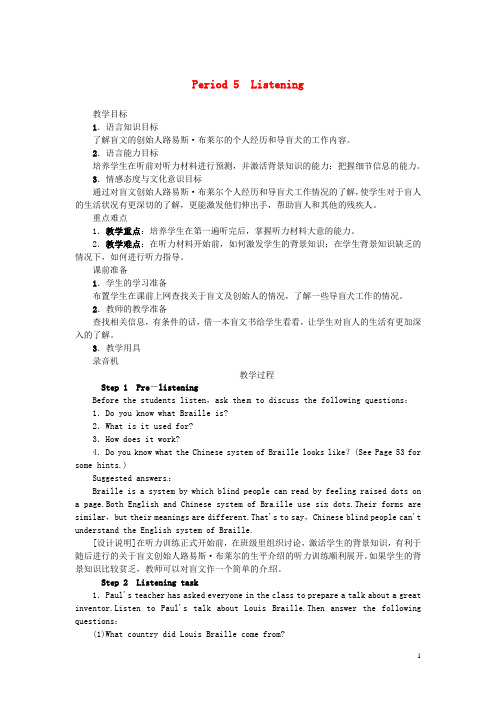
Period 5 Listening教学目标1.语言知识目标了解盲文的创始人路易斯·布莱尔的个人经历和导盲犬的工作内容。
2.语言能力目标培养学生在听前对听力材料进行预测,并激活背景知识的能力;把握细节信息的能力。
3.情感态度与文化意识目标通过对盲文创始人路易斯·布莱尔个人经历和导盲犬工作情况的了解,使学生对于盲人的生活状况有更深切的了解,更能激发他们伸出手,帮助盲人和其他的残疾人。
重点难点1.教学重点:培养学生在第一遍听完后,掌握听力材料大意的能力。
2.教学难点:在听力材料开始前,如何激发学生的背景知识;在学生背景知识缺乏的情况下,如何进行听力指导。
课前准备1.学生的学习准备布置学生在课前上网查找关于盲文及创始人的情况,了解一些导盲犬工作的情况。
2.教师的教学准备查找相关信息,有条件的话,借一本盲文书给学生看看,让学生对盲人的生活有更加深入的了解。
3.教学用具录音机教学过程Step 1Pre-listeningBefore the students listen,ask the m to discuss the following questions:1.Do you know what Braille is?2.What is it used for?3.How does it work?4.Do you know what the Chinese system of Braille looks like?(See Page 53 for some hints.)Suggested answers:Braille is a system by which blind people can read by feeling raised dots on a page.Both English and Chinese system of Bra ille use six dots.Their forms are similar,but their meanings are different.That's to say,Chinese blind people can't understand the English system of Braille.[设计说明]在听力训练正式开始前,在班级里组织讨论,激活学生的背景知识,有利于随后进行的关于盲文创始人路易斯·布莱尔的生平介绍的听力训练顺利展开。
- 1、下载文档前请自行甄别文档内容的完整性,平台不提供额外的编辑、内容补充、找答案等附加服务。
- 2、"仅部分预览"的文档,不可在线预览部分如存在完整性等问题,可反馈申请退款(可完整预览的文档不适用该条件!)。
- 3、如文档侵犯您的权益,请联系客服反馈,我们会尽快为您处理(人工客服工作时间:9:00-18:30)。
2021人教版选修七unit1《livingwell》word教案51.语言知识目标了解盲文的创始人路易斯·布莱尔的个人经历和导盲犬的工作内容。
2.语言能力目标培养学生在听前对听力材料进行推测,并激活背景知识的能力;把握细节信息的能力。
3.情感态度与文化意识目标通过对盲文创始人路易斯·布莱尔个人经历和导盲犬工作情形的了解,使学生关于盲人的生活状况有更深切的了解,更能激发他们伸出手,关心盲人和其他的残疾人。
重点难点1.教学重点:培养学生在第一遍听完后,把握听力材料大意的能力。
2.教学难点:在听力材料开始前,如何激发学生的背景知识;在学生背景知识缺乏的情形下,如何进行听力指导。
课前预备1.学生的学习预备布置学生在课前上网查找关于盲文及创始人的情形,了解一些导盲犬工作的情形。
2.教师的教学预备查找相关信息,有条件的话,借一本盲文书给学生看看,让学生对盲人的生活有更加深入的了解。
3.教学用具录音机教学过程Step 1Pre-listeningBefore the students listen,ask them to discuss the following questions:1.Do you know what Braille is?2.What is it used for?3.How does it work?4.Do you know what the Chinese system of Braille looks like?(See Page 53 for some hints.)Suggested answers:Braille is a system by which blind people can read by feeling raised dots on a page.Both English and Chinese system of Braille use six dots.Their forms are similar,but their meanings are different.That's to say,Chinese blind people can't understand the English system of Braille.[设计说明]在听力训练正式开始前,在班级里组织讨论,激活学生的背景知识,有利于随后进行的关于盲文创始人路易斯·布莱尔的生平介绍的听力训练顺利展开。
假如学生的背景知识比较贫乏,教师能够对盲文作一个简单的介绍。
Step 2Listening task1.Paul's teacher has asked everyone in the class to prepare a talk about a great inventor.Listen to Paul's talk about Louis Braille.Then answer the following questions:(1)What country did Louis Braille come from?(2)What disability did he have?(3)What did books for the blind look like when Louis was a boy?(4)What were the two problems with the books for the blind?(5)What invention gave Louis the idea for his system?(6)What advantages do you think Louis's system has?Suggested answers:(1)He came from France.(2)He was completely blind.(3)They were ordinary books with letters raised up off the page.(4)The letters were huge and difficult to read,and the books were very expensive.(5)A system for soldiers to send and receive messages in the dark.(6)I think Braille system has the advantage of being easy to learn,and so it is easy to produce books of normal size.It helps make blind people independent because they can read as much as sighted people do.2.Before the students do Exercise 3 on Page 50,discuss the events in Louis Braille's life by asking questions as follows:How did Louis become blind?How old was he when he became blind?What event in his life gave Louis his idea about inventing a reading system for the blind?How old was he when this happened?How old was he when he finally perfected the code?How old was Louis when he died?3.Year Age Event1809 ________________1813 4 ________________1819 10 ________________1821 12 ________________1824 15 ________________1827 18 ________________1852 43 ________________Suggested answers:Year Age Event1809 Born1813 4 Became_completely_blind1819 10 Sent_to_school_in_Paris1821 12 Heard_a_soldier_talk_about_a_system_consisting_of_a_raised_system_of_dots1824 15 Completed_the_Braille_system_of_touch_reading1827 18 First_Braille_book_published1852 43 Died生自己组织语言,只需答出要点即可。
在完成时刻轴之前,先进行讨论,能够降低第三个环节的难度。
同时引导学生注意,介绍人物能够以时刻为线索。
假如学生的口语表达能力比较强,还能够在听力训练完成后,请学生用英语简单介绍盲文的创始人路易斯·布莱尔的情形。
Step 3ListeningT:We've got some information about Braille and known how the blind read.If the blind goout,the guide dog can help a lot.Now let's enter another listening on Page 46.1.Listen to the whole tape for the first time.Then write down the main idea of the listening.Suggested answer:The main idea of this listening is to show how a guide dog is trained and its usefulness to its owner.(1)How did Sara get to work on her own?(2)Has Sara always been blind?How do you know?(3)What will Lucy learn first at Sara's home?(1)By train on her own.(2)No.She said her mother had helped her a lot since her accident.(3)How to get to the train station.3.Listen to Part 1 again and complete the dialogue below.PHIL:Definitely.She told me____________ since her accident.MOTHER:Well,I've____________,but I know Sara wants to be ____________.PHIL:Well,with Lucy's help she will be.How's Lucy ____________,by the way?MOTHER:Oh,it's like ____________,isn't it,Sara?SARA:Yes.She's been ____________ everything in the house and she knew which was my bedroom ____________.Keys:PHIL:Definitely.She told me how_much_you've_helped_her since her accident.MOTHER:Well,I've done_my_best,but I know Sara wants to be more_independent.PHIL:Well,with Lucy's help she will be.How's Lucy settling_in,by the way?MOTHER:Oh,it's like she's_always_been_here,isn't it,Sara?SARA:Yes.She's been smelling everything in the house and she knew which was my bedroom right_away.4.Listen to Part 2 and answer the questions in pairs.(1)How did Lucy go across the street?(2)What is Phil going to teach Lucy after lunch?(3)How will Lucy improve Sara's life?Suggested answers:(1)She sat down at the crossing and waited till the cars stopped,then she stood up and took Sara straight across the road.(2)How to get off the train and walk to Sara's workplace.(3)Lucy will help Sara resume her previous life,become as independent as she used to be and give her the confidence to lead a normal life.5.Listen to Part 2 again and complete the dialogue below.PHIL:We'll ______Lucy______rest and then we'll ask her______Sara to the station again.SARA:Then Phil's going to ______ Lucy ______ the train and ______ my office.__ ____,Lucy and I will be going to work ______.MOTHER:That's______.I'm so ______ you.Keys:PHIL:We'll give Lucy a_bit_of_rest and then we'll ask her_to_take Sara to the station again.SARA:Then Phil's going to show Lucy how_to_get_off_the train and take_me_to my office.In_a_few_days,Lucy and I will be going to work on_our_own.MOTHER:That's fantastic.I'm so pleased_for you.[设计说明]那个听力训练是围绕导盲犬进行的。
